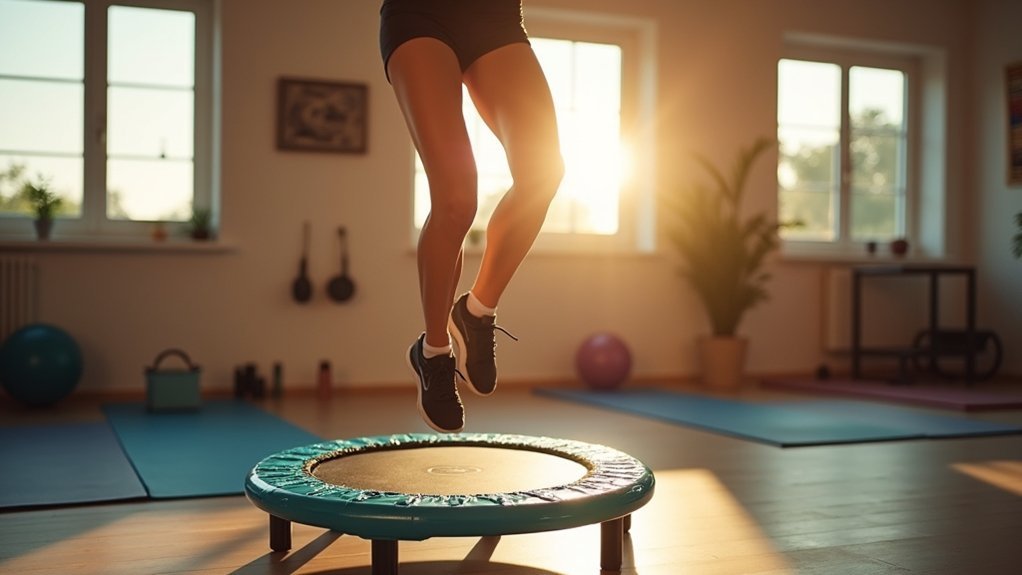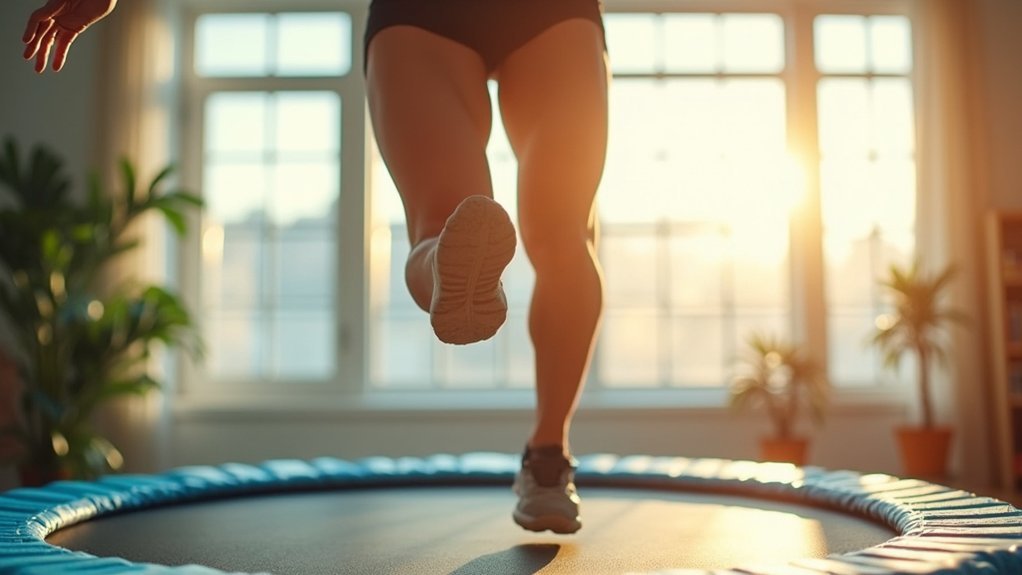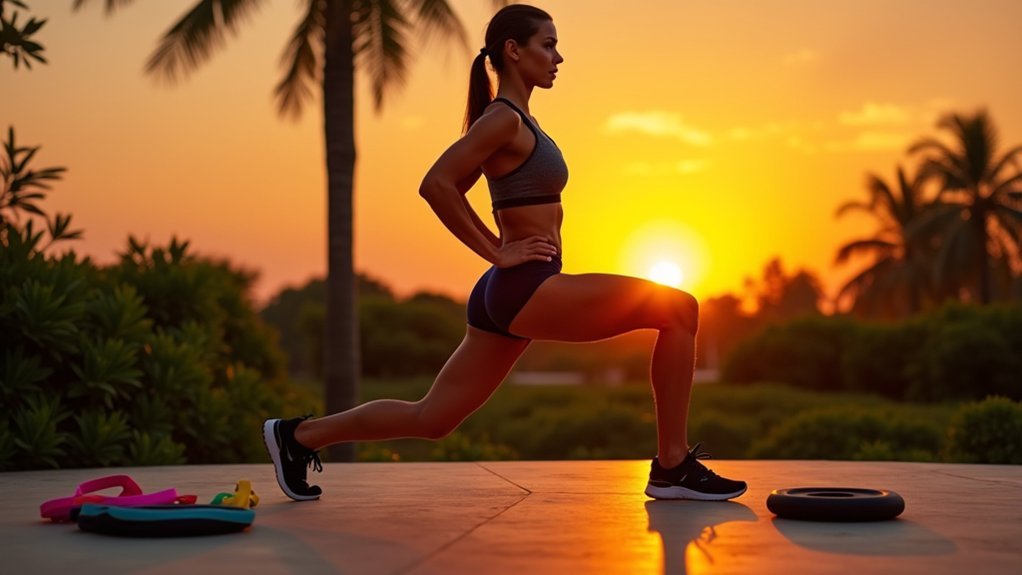These seven mini-exercises will transform your thighs: basic bounces on a rebounder, side-to-side movements, resistance band lateral pulls, modified jumping jacks, banded squat bounces, isometric adductor holds with a small ball, and multi-planar hops. Perform each for 60+ seconds to trigger growth hormone release and engage all adductor muscles. You’ll need minimal equipment—just a small exercise ball (4-8 inches) and resistance bands for maximum results. Discover how these targeted movements can reshape your lower body in just weeks.
The Science Behind Mini-Exercises for Thigh Sculpting

While seemingly simple, mini-exercises leverage sophisticated muscle activation strategies to transform your thighs without demanding extensive workout time. These movements capitalize on isometric contractions that engage muscles without joint movement—perfect if you’re a beginner or recovering from injury.
What makes these exercises effective is their focus on both concentric and eccentric phases, creating microtears essential for muscle growth. By incorporating multi-planar movements, you’re simultaneously targeting all adductor muscles (longus, brevis, and magnus).
The controlled dual-phase activation creates strategic muscle damage while engaging your entire inner thigh complex for balanced development.
The science is compelling: mini-exercises increase mitochondrial density and enhance capillary networks, improving nutrient delivery to working muscles. Incorporating a small exercise ball between your legs during these movements significantly increases muscle activation in the inner thighs.
When you perform high-rep sets exceeding 60 seconds under tension, you trigger growth hormone release that accelerates sculpting results. The 4-0-2-0 tempo manipulation increases time under tension by 300%, maximizing results from minimal movement.
Essential Equipment for Your Rebounding Thigh Workout
When working on rebounding thigh exercises, you’ll want to select a small exercise ball (4-8 inches) to place between your thighs for targeted adductor engagement.
Resistance bands can transform basic bounces into powerful thigh sculptors by creating constant tension against your leg movements.
For optimal results, consider rebounders with safety pads covering springs to ensure your feet won’t get caught between coils during lateral movements.
These simple equipment additions will maximize your results without requiring a complex setup, making them perfect complements to your spring or bungee rebounder.
Optimal Ball Size Selection
Selecting the right exercise ball size transforms your rebounding thigh workout from merely effective to truly exceptional.
Your height directly determines the ideal ball diameter—45 cm for those under 5′, scaling up to 85 cm for individuals taller than 6’8″. Those with longer legs might benefit from slightly larger balls to maintain proper alignment. Maintaining proper knee alignment during exercises prevents injury and maximizes the effectiveness of each movement.
- Check your posture – Your hips should align with your knees when seated, preserving your spine’s natural curve.
- Adjust inflation – Fine-tune air pressure to achieve best height for your proportions.
- Consider portability – Choose a ball that’s easy to transport if you’ll use it in multiple locations.
- Ensure durability – Select materials that safely support your weight during dynamic exercises.
Resistance Bands Benefits
Four powerful benefits make resistance bands essential for your thigh-sculpting routine. Unlike traditional weights, these versatile tools engage your muscles throughout the entire range of motion, creating constant tension that builds strength efficiently.
You’ll appreciate how bands are gentler on your joints while still effectively targeting quadriceps, hamstrings, and glutes. This makes them ideal for rehabilitation or if you’re managing knee issues.
Their practical advantages can’t be overstated – they’re portable, inexpensive, and require minimal space, allowing you to maintain your routine anywhere. Resistance bands provide tension in all phases of your movement, including concentric, eccentric, and isometric contractions.
Whether you’re traveling or short on workout space, resistance bands deliver results.
Most importantly, bands offer progressive resistance that adapts to your strength level, making them perfect for beginners and advanced users alike while improving stability and balance in your lower body.
Beginner’s Guide to Rebounding Thigh Exercises

You’ll see impressive thigh results by incorporating rebounding into your fitness routine.
Start with basic bounces while maintaining proper posture and engagement of your quadriceps and hamstrings. The Health Bounce position with feet hip-width apart and a slight forward hinge maximizes thigh muscle activation.
As you progress, add side-to-side movements and modified jumping jacks to target different angles of your thigh muscles for thorough toning.
Bounce For Thigh Strength
While many traditional leg workouts leave you with sore joints, rebounding offers a gentler path to sculpted thighs. This low-impact exercise engages your quadriceps, hamstrings, and stabilizer muscles with every bounce, effectively toning your lower body without stressing your joints.
- Your thigh muscles constantly activate during rebounding as they work to maintain balance and control each jump.
- The unstable surface strengthens stabilizer muscles, improving overall coordination and reducing fall risk.
- Regular bouncing promotes bone density while naturally shaping your legs, thighs, and buttocks.
- You’ll engage multiple muscle groups simultaneously, creating a more efficient workout than isolated exercises.
The holistic approach of rebounding means you’re not just building stronger thighs—you’re improving balance, coordination, and overall fitness with every bounce. This form of exercise is particularly beneficial for older adults looking to improve their fear of falling while getting a quality thigh workout.
Mini-Trampoline Toning Techniques
Ready to put those rebounding benefits into action? Start with a proper warm-up: perform 90-second deep squat stretches with leg extensions, followed by side bends while bouncing to engage your core and lateral thigh muscles.
For maximum thigh toning, try alternating leg scissors while maintaining a hip-width stance. Squeeze an exercise ball between your thighs during initial bounces to activate adductors. Begin with basic bouncing on your mini trampoline with your heels slightly lifted for proper form.
Incorporate lifted squat bounces with abdominal engagement, focusing on heel pressure for quad activation. Optimize your workout by adjusting your rebounder’s tension—softer for less impact, firmer for increased resistance.
Work in intervals (40 seconds on, 20 seconds rest) to maintain fat-burning heart rates. Don’t forget to cool down with static adductor stretches and lateral leg swings to prevent injuries.
Mastering the Basic Bounce for Inner Thigh Toning
The foundation of effective inner thigh sculpting begins with proper bounce technique on your mini-trampoline.
Position your feet hip-width apart with a pillow or ball between your thighs. Maintain a neutral spine with a heavy tailbone to activate your lower abs and pelvic floor while syncing your arm movements with your breath. For maximum engagement, point your toes during movement phases as this helps lengthen the leg muscles.
- Squeeze the tension device during upward bounce to maximize time-under-tension and engage adductors.
- Keep micro-movements continuous to prevent momentum reliance and force sustained muscle activation.
- Adjust pillow thickness or ball size to target specific areas and increase resistance as you progress.
- Maintain parallel toe alignment to protect your knees while focusing on controlled acceleration/deceleration phases.
High-Intensity Rebounding Intervals for Quadriceps Strength

To strengthen your quadriceps effectively, high-intensity rebounding intervals provide a dynamic, low-impact solution that builds power while protecting your joints.
Incorporate Tabata-style routines with 20 seconds of intense jumping followed by 10 seconds of rest for maximum quad engagement.
Try alternating between jump squats and basic bounces to target your quads intensively. Sprint intervals on the trampoline will improve both cardiovascular fitness and quad speed, while agility drills with quick directional changes enhance reaction time. Rebounding exercises are especially effective as they engage multiple muscle groups simultaneously, including your glutes and core along with your quadriceps.
Before starting any rebounding HIIT routine, consult your healthcare provider, especially if you have pre-existing conditions.
Always warm up thoroughly, verify your mini-trampoline is secure, and consider quality jumping shoes for better stability.
Follow each session with quadriceps stretches to minimize soreness.
Low-Impact Mini-Exercises for Hamstring Definition
Sculpting defined hamstrings doesn’t require heavy gym equipment or high-impact movements that stress your joints.
These low-impact exercises target your posterior thigh muscles for definition while maintaining joint health.
Gentle on joints, powerful on results—these hamstring-focused movements build definition where it matters most.
1. Bodyweight Glute Bridges – Perform 2-3 sets of 10-15 reps, focusing on a strong heel drive and isolated contractions to enhance your mind-muscle connection.
2. Romanian Deadlift Variations – Use household items like water jugs or backpacks while maintaining a neutral spine and soft knee bend.
The 3-second descent activates Type II muscle fibers. Focusing on proper form during this exercise is crucial as it directly targets the ischial tuberosity attachment where all hamstring muscles originate.
3. Single-Leg Deadlifts – Reach to mid-shin level to maximize hamstring stretch while correcting muscle imbalances between legs.
4. Elevated Hamstring Slides – Use furniture sliders or paper plates for eccentric-focused training that exceeds traditional curl ranges for ideal muscle lengthening.
Targeted Rebounding Movements for Stubborn Thigh Areas
Rebounding offers a unique solution for those stubborn thigh areas that don’t always respond to traditional exercises. By alternating your speed and creating customized intervals on the mini trampoline, you’ll target precise areas with less joint stress than conventional workouts.
Focus on alternating heel movements toward your glutes to engage inner thighs, or try single leg hops to improve both balance and muscle definition. You don’t need lengthy sessions—even 6-15 minutes of consistent rebounding can produce visible results. Using a small exercise ball positioned between your thighs adds resistance for more effective inner thigh engagement.
For enhanced sculpting, gradually increase your workout intensity and consider adding light weights to your routine.
Remember to maintain proper posture throughout your bouncing session, ensuring your thighs and glutes work together through integrated movements for thorough toning.
Combining Resistance Bands With Your Rebounding Routine
Adding resistance bands to your rebounding workout creates the perfect storm for thigh-sculpting through Band Tension Bounce Intervals that challenge muscles with every jump.
You’ll maximize results with Lateral Resistance Jumps that target outer thighs while the elasticity of bands intensifies each movement pattern. The workout incorporates strategic breaks between strength and cardio blocks to optimize recovery while maintaining intensity.
Multitasking Muscle Activation happens naturally as your body fights against band resistance while maintaining balance on the unstable rebounder surface, creating a compound effect that transforms stubborn thigh areas.
Band Tension Bounce Intervals
When you combine resistance bands with rebounding exercises, you’ll create a powerful fusion that transforms ordinary bouncing into a sculpting powerhouse for your thighs.
Secure loop bands under your feet during bounces to maximize resistance where you need it most—through the entire movement cycle.
For maximum thigh-sculpting benefits:
- Alternate 40-second rebounds with 20-second band-resistance moves to maintain elevated heart rate while targeting different muscle fibers.
- Incorporate multi-planar movements by combining forward jumps with lateral band pulls to engage inner and outer thigh muscles.
- Add isometric pauses at the bottom of each bounce while maintaining band tension to intensify muscle activation.
- Progress gradually by folding bands for increased resistance as your strength improves, challenging your thighs through progressive overload.
This approach creates a continuous flow of exercises with minimal transition time, maximizing both cardiovascular conditioning and muscle development in your lower body.
Lateral Resistance Jumps
Supercharge your thigh-sculpting routine by integrating lateral resistance jumps into your mini trampoline workouts.
Anchor a looped resistance band to a stable surface or wrap it around your thighs for continuous tension throughout each jump.
Maintain an athletic stance with slightly bent knees and engaged core as you explode sideways onto your rebounder.
Land softly with bent knees, minimizing ground contact time before your next rep.
These jumps primarily target your quads, glutes, and hip abductors while engaging your core stabilizers. For maximum effectiveness, focus on loading the inside leg properly before each explosive lateral movement.
Choose appropriate band resistance—thicker for advanced training, lighter for speed development.
Start with 3 sets of 8-10 jumps per side, allowing 48 hours between sessions.
Always check band security before jumping to prevent snapback injuries, and monitor knee alignment to protect your joints.
Multitasking Muscle Activation
Resistance bands take your mini trampoline workout from effective to extraordinary when you combine them with bouncing exercises. This duo creates continuous tension that forces muscles to work through complete contractions while maintaining the joint-friendly benefits of rebounding.
- Start simple – Anchor light bands (15-30 lbs) to fixed points or ankles for beginner-friendly combos like banded leg extensions during basic bounces.
- Target multiple muscles – Perform lateral pulls during jumps to engage often-neglected inner and outer thigh muscles. The total body transformation approach ensures all muscle groups receive attention, maximizing your workout efficiency.
- Maximize calorie burn – Shift between seated band exercises and rebounds without rest to double your metabolic impact.
- Build functional strength – Practice banded lateral hops to improve athletic agility while strengthening stabilizing muscles that prevent injury.
Progressive Thigh-Sculpting Rebounding Plan
Transforming your thigh muscles requires a systematic approach that combines targeted movements with progressive intensity. Start with 20-minute workouts focusing on controlled bounces that activate your quads, hamstrings, and inner/outer thighs.
A calibrated workout regimen transforms thighs through precision movements and strategic progression.
Begin in the adaptation phase, mastering basic up-down mechanics before advancing to compound moves like lunge-jumps and plyometric tucks. Add a ball or pillow between your thighs during lateral jumps to enhance inner thigh engagement.
As you progress, shift from 6-minute quick sessions to 15-20 minute strength routines. Incorporate tiny tucks, single-leg heel taps, and pulse squats to target specific muscle groups. The mind-to-muscle connection during flexing is essential for maximizing results and ensuring proper activation of target areas.
The low-impact nature of rebounding minimizes joint stress while multi-directional movements strengthen stabilizers and improve functional strength.
Recovery Techniques for Optimal Thigh Muscle Growth
While your rebounding workouts build impressive thigh strength, what happens between sessions actually determines your results. Your recovery strategy directly impacts how quickly and effectively your thigh muscles repair and grow.
- Compress for success – Wear graduated compression leggings (15-30 mmHg) immediately after your workout and overnight to enhance muscle protein synthesis and reduce swelling.
- Contrast therapy works – Try 15-minute sessions alternating between hot and cold water to reduce inflammation markers by up to 30% and decrease muscle soreness. The ideal approach uses a 1:1 ratio of 7 rotations between 1 minute hot (38-40°C) and 1 minute cold (10-15°C) immersion.
- Roll it out – Use foam rolling or a percussion gun (40-50Hz) on your quads and hamstrings to release fascial tension and improve circulation without tissue damage.
- Fuel smart, recover faster – Consume 0.4g/kg of protein within 2 hours post-workout to maximize muscle repair while limiting caffeine before sleep.
Tracking Your Progress: Measurements That Matter
To optimize your thigh-sculpting journey, measuring your progress accurately matters just as much as the exercises themselves.
Use a non-stretch tape measure and establish consistent landmarks—5cm and 10cm above your kneecap—marked with adhesive tape.
Measure in a supine position to eliminate variables, taking three consecutive readings at the same time of day. Focus on mid-thigh, proximal quadriceps, and distal quadriceps measurements.
Don’t forget to compare both legs to detect imbalances. Track weekly changes but prioritize long-term trends over daily fluctuations. A 2.5% circumference increase typically indicates visible hypertrophy. Daily weighing may cause undue stress, so understanding normal weight fluctuations is important for mental well-being.
Be aware that post-workout water retention can inflate measurements, so avoid measuring after intense sessions. For thorough tracking, pair your measurements with progress photos and consider using digital tracking apps.
Incorporating Rebounding Thigh Exercises Into Your Weekly Schedule
Designing an effective rebounding schedule requires strategic planning to maximize thigh-sculpting benefits while allowing proper recovery. The ideal approach combines frequency, duration, and intensity progressions that respect your body’s adaptation timeline.
- Start with 3 weekly sessions of 30 minutes – research shows this frequency balances recovery needs while promoting mobility and strength gains.
- Include a 5-10 minute warm-up with gentle bounces before progressing to targeted exercises like plié bounces and lateral bounds. Incorporating these movements engages multiple muscle groups simultaneously while supporting your overall fitness goals.
- Gradually increase intensity by incorporating HIIT intervals (30s effort/30s rest) and working at 60-80% of your maximum heart rate.
- Implement a progressive 12-week plan – begin with 15-minute sessions focused on movement patterns before adding resistance and reducing ground contact time.
Frequently Asked Questions
How Long Before I See Results From Mini-Exercises?
You’ll notice initial endurance gains within 10 days. First visible changes appear after 3-4 weeks of consistent mini-exercises. For measurable thigh circumference reduction, you’ll need at least 4 weeks of committed effort.
Can Mini-Exercises Replace Traditional Gym Workouts Completely?
Mini-exercises can replace gym workouts for basic fitness and maintenance, but you’ll need traditional training for maximum strength gains. They’re ideal complements to gym sessions, not complete substitutes for serious muscle growth.
Are Mini-Exercises Suitable for People With Knee Problems?
Yes, you’ll find mini-exercises suitable for knee problems when properly selected. They’re often low-impact, can strengthen supporting muscles, and improve mobility. Always consult your healthcare provider before starting and focus on proper technique.
How Do Mini-Exercises Compare to Squats for Thigh Sculpting?
Mini-exercises target specific muscles with less intensity, while squats engage your entire lower body more extensively. You’ll build localized strength with mini-exercises, but squats provide more thorough thigh sculpting through greater muscle activation.
Should I Do Mini-Exercises Daily or Alternate Days?
You can do low-impact mini-exercises daily (leg lifts, wall sits), but alternate days for resistance-based movements (weighted lunges). Daily light work improves consistency while alternating intense sessions allows proper muscle recovery.
In Summary
You’ve now got 7 powerful rebounding exercises to transform your thighs. Remember, consistency is your key to success. Start with just 10 minutes daily and gradually increase as your strength improves. Don’t expect overnight results—give your body 4-6 weeks to show visible changes. Track your progress, listen to your body, and you’ll soon enjoy firmer, more sculpted thighs that you’ll love showing off.





Leave a Reply